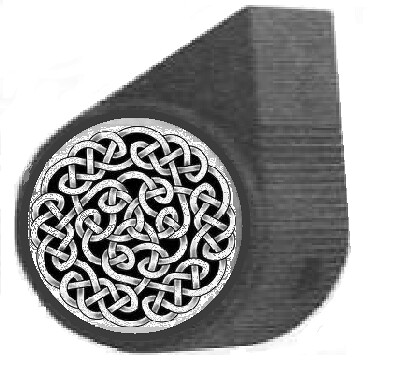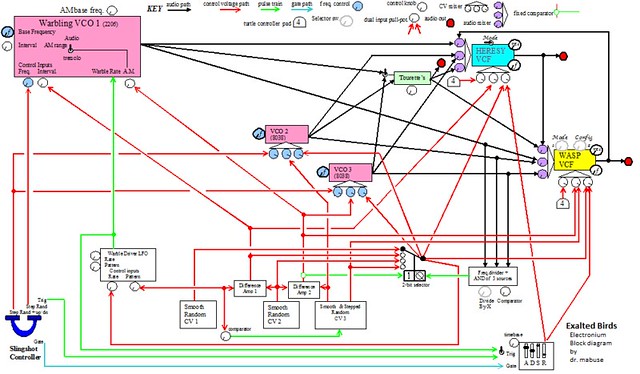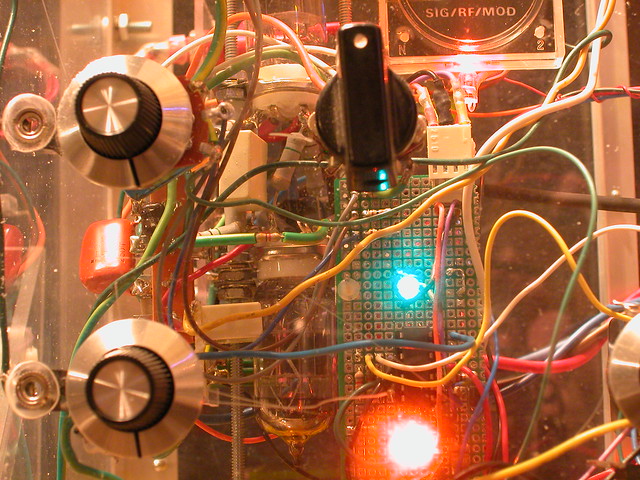Sochastacht
A sprawling dissertation on the madness in my method for building electroniums .
I’m Irish, and my grandfather was even more so. As kids we simply accept the peccadilloes of our elders. Thus there were some odd principles that were woven into my grandfather’s life that didn’t strike me as odd until a couple of decades after his death. It was not until I was more than a few paces over the hill myself that I learned how deeply rooted in ancient Celtic culture some of those principles are.
My grandfather was a treasure trove of the aforementioned peccadilloes but that’s not just another story … it would be several hundred other stories!
In the interest of focus I present just one principle (with two sides):
1-Evil travels in straight lines.
2-Sochastacht
First let’s have a few words about the word itself.
Sochastacht is a gaelic word. English has no direct translation and, in fact, hasn’t had much of a conceptual translation either, until very recent developments in physics . It translates very roughly to ‘ happy complexity or intricacy’ , the ‘happy’ being a value judgment built into the word . The Celts put it in there because in their world-view the tangled nature of sochastacht thwarted the progress of evil which always tries to travel in straight lines. It seems to me that science is just now comprehending sochastacht by scratching the surface of chaos theory and turbulence. Our physicists and mathematicians are recognizing that this phenomenon is essential to understanding the reality of the universe. I submit that sochastacht could be construed to mean something close to ‘turbulence’. But our science (ostensibly & ideally) abhors assessing value , so scientists would leave the ‘happy’ part out of the word. Furthermore in English, ‘chaos’ and ’turbulence’ are already pejorative terms . Chaos is most commonly associated with what happens if law and order break down, and turbulence is the bane of every white-knuckle flier. My grandfather knew better and so did his Celtic ancestors. Chaos is by no means intrinsically bad. It is the confluence of the streams. It is the path of life as it is truly lived. It is to be welcomed as a sign of vigor and wisdom. On the other hand, evil, is always striving for shortcuts, efficiencies, straight lines and the false order of simple geometry. These views are hardly scientific, but they ring true with me nonetheless. The first time my Grandfather took an airline flight he got off the plane dejected at seeing all the straight lines that mechanized agriculture had graved into the earth in his beloved Midwest.
I am from a different generation. I idolized NASA as a kid and just saw my grandfather as perilously old fashioned. But it turns out Grandpa and his line of Celtic ancestors had a very compelling point; one that even applies to designing electronic instruments.
sochastacht in design
I design my electroniums intuitively. I’ve now built enough of them to have observed some of my own habits. One of them is that I look for points in a circuit that impart regularities on the fluctuations of the signal … and then I screw with them, usually by importing some irregularity from another point in the circuit. I’ve learned that moderation is essential. If I overdo this habit, the result becomes undistinguished white noise. The art is in carefully choosing how much chaos is required to elevate all the law and order from being merely pretty to being beautiful.
Another particular habit that I repeat almost unconsciously now is that I construct an analog white-noise source first.*. I do this in the same way a good cook in New Orleans will find herself stirring a rue fifteen minutes before she knows what she’s going to cook. Contrary to the complaints of some of my more specious detractors, I wish to declare once and for all, that I do not like the sound of white noise. What I do like is the fact that white noise can be tapped to introduce a measure of turbulence into a signal that’s behaving just a bit too regularly and efficiently for me. Human hearing evolved with an extraordinarily acute ability to discern patterns. The more repetitious the pattern the more our minds will execute a rather contrary but miraculous maneuver and start to exclude it from the foreground of attention, allowing us to hear through repetitious sounds to access irregular ones. I firmly believe that the link between this trait and our perception of what constitutes ‘music’ is inestimably close. Our ears are looking for sochastacht and that’s what biases the design of my electroniums as well as my taste in music.
But the application of the principle goes far beyond the circuit design.
sochastacht ‘controls’
I apply it to the implementation of controls. Analog enthusiasts love knobs. They love having lots of them to twist. This is how analog synthesizers are played. In the orthodoxy of analog design, the knobs are tools of control. I do this… and the machine does that… very quid pro quo. Blanket application of this rather rigid relationship does not elicit the best music from me in performance. So I apply the principle of sochastacht in implementing some controls that do not exert a direct and immediate effect on the output of the circuit. A good example of this is a probability control. Raising the control increases the chance that some effect will occur but does not insure that it will occur immediately. I use this type of control very often. It is rather easy to implement by using a comparator to compare a threshold set by a panel control to white noise.
Viewed on an oscilloscope, white noise is denser in the middle of it’s range and sparser toward it’s edges (a natural expression of the famous ‘bell curve’ from statistics class) if you tell the comparator to fire-off a trigger pulse every time the white noise crosses the threshold the pattern of output pulses will always be random but they will be more ‘common’ in the middle of the noise and ‘rarer’ (or sparser) at the extremes. I find this very useful and it formed one of the foundations of my ‘Goldberg Function Generator’ Another ‘socastacht-style control is a one that sets initial conditions in a very complex process wherein the output must undergo myriad permutations before manifesting itself. Changing the initial conditions , or rules that govern the permutations will definitely affect the output but won’t do so immediately or at a point in the future that is entirely predictable. Hmmm, kinda like real life, huh?
I am frequently accused of doing this just be weird. But my response is that I’m doing this because it makes the signals that originate from electronic sources sound more natural. Mind you this is not imitation of acoustic instruments. (I find that pianos are best at making piano sounds so I leave it to them) It is my attempt to make the rather bland simplistic waves from electronic oscillators more interesting by forcing a bit of the big wild universe into their environment. I will confess that while I have no interest in imitating acoustic instruments I deeply admire them because they are capricious, inaccurate, and inefficient and that’s why they can sound so good. Back in the 80’s I had the good fortune to be a part of some early projects in the quest for commercially viable software that could imitate acoustic instruments convincingly. In this venture I was exposed to some very sophisticated (for the time) analysis of the behavior of sound waves in the air. Wowee! Those ‘simple’ acoustic instruments sure do get up to some fancy shit; fancy and complex! I discovered that this kind of software development was not much to my taste and I abandoned it for other pursuits. But I never forgot what I learned. The waveforms produced by a single tine on a Kalimba contained a universe of complex interactions. So in the mid 1990s when the analog renaissance was dawning, I started seeing internet discussions of the relative quality of VCOs. The geometric symmetry of a (ie) triangle wave (as viewed on an oscilloscope) was judged to be a hallmark of superiority. No way, thought I! In nature the good sounding waves all look like kind of a mess on the scope. Seeing the vehemence with which idealized ‘purity’ was propagandized on the web ultimately led to my departure from talking about synthesizers there. When a ‘neatness-counts’ ethic started to aggressively gain adherents. I knew that the far less visually ‘elegant’ aesthetics of sochastacht would become an endangered species. My contrary position was that the audience does not show up to view the scope (or the faceplate ) those things are irrelevant to music. So I focus on what sounds best to me and everything visual takes a backseat. But the internet (at present) can do a much better job promoting visuals (as high resolution images) than it can at reproducing high resolution sounds .
sochastact in construction
Now for the coup de grace! I have prosthelytized sochastacht to many a tight-assed engineer and I’m proud to report that more than a few of them could,after a bit of a harangue, appreciate that there was at least some advantage in deliberately messy waveforms or design concepts. But only the most broad minded of then could embrace the next arena into which I pushed the principle; construction.
Now come on doc, That’s just an excuse for making messy shit .
(I just LOVE to give facetious responses to that accusation. But this is intended as a serious essay , so I’ll play it straight)
Formally: No.
I’ll use a very common and beloved practice as an example. Almost all commercial builders of analog gear deal with wire-runs in the same fashion. They bundle them together into ‘trunks’ of parallel wires and route them in 90-degree paths around the device. This makes for a deliciously neat and accessible appearance and affords substantial benefits for maintenance and repair**. It’s a practice with many advantages. I do not dispute that at all. The ‘pros’ will tell you that it’s the only way to go… and THAT’S what I dispute. Ask the pros who do repairs on another type of device… surgeons, especially neurosurgeons. Ask them how nature lays-out neurons and ganglia , and then try to argue that simple geometry is the ‘only way to go’. Biological conduits, especially nerves, are a mess, and they’re a mess for a reason. With apologies to my friends in the life-sciences. I will vastly oversimplify the reason. Messes reduce crosstalk, and when you’re building a device by evolution, like legs, to run like hell from a leopard, there are great advantages to developing a method that will ensure that the thigh muscles respond to the thigh-muscle-signals rather than the big toe muscles. If the nerves for the two appendages were bundled ‘neatly’ in parallel, the chances are much higher that a critical impulse could jump the tracks and end up routed to the wrong place. Leaving our poor ‘device’ vigorously flexing his big toe immediately before being consumed by a leopard. Nerve impulses are electrical and nature ’learned’ that random ‘rat’s nest ‘ formations minimize the places where such misfires can occur. Some of my early circuits had very high crosstalk problems and I found that one easy (and cheaty) way to reduce that significantly was to unbundle the wires , keep the runs short, and let the rat’s nest unfurl in all it’s voluptuous horror! I favor clear plastic for cabinets for many reasons but I demurred from using it back then because I was ashamed of the unkempt look of my innards. But after a discussion with friend who studies the DNA of nerves I decided to ‘let my freak flag fly’ . A few very accomplished engineers have seen my contraptions and sniffed: “if that was how I wired a circuit, I sure as hell wouldn’t be putting it in clear plastic”. That’s a fair cop! My response is that these guys are lucky that their own skin isn’t transparent. They’d be ashamed of the way they were wired as well. I do not make things deliberately messy. I make them deliberately complex. Then, I decline to intervene in the messiness of their complexity with an arbitrary concept of order or neatness. I’ve observed mother nature for decades and I’m convinced that this is how she does it too. Always listen to your mother!
In closing, the principle of sochastacht just ‘feels right’ to me. It keeps music interesting to me. It quiets noisy circuits, and it honors my grandfather and his gift to me from the Celtic knot designers among my ancestors.
Slainte!
*I am profoundly indebted to Grant Richter for providing me with the foundations of a circuit that produces true white noise reliably and consistently.
**Common sense and long experience with the innards of electronic devices compels me to post a few words on behalf of the poor beleaguered repair & maintenance techs . Bundled wire runs are a good thing for them, and my rat’s nest methods are their bane. For this reason I declare that I would NEVER in good conscience hand one of my ‘masterpieces’ of sochastacht lunacy to any other technician and ask him or her to fix or maintain it unless I was prepared to pay them on a strict unlimited time and materials basis and a generous bonus to boot for all their extra trouble. This is also why it would be silly and irresponsible for me to even consider selling any devices. They’d require the support of someone as devoted and intimate with their workings as myself; not bloody likely!




Comments are closed.